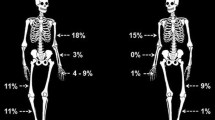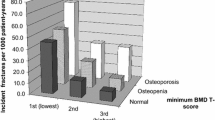Abstract.
Osteoporotic fractures are a major public health problem, particularly in women. Bone mineral density (BMD), bone mineral content (BMC), and bone size have been regarded as important determinants of osteoporotic fractures. In 1449 women over age 30 years, we studied the detailed relationship, at the spine and hip, between BMD, BMC, and bone areal size (all measured by dual-energy X-ray absorptiometry) and compared their relative magnitudes in fracturing and non-fracturing individuals. We find that, (1) BMD and BMC are significantly higher at the spine and hip in non-fracturing women. Bone areal size is significantly larger at the spine in non-fracturing women; however, the significance disappears when adjustment is made for the significant difference of height (stature) between fracturing and non-fracturing women. In contrast to the spine, bone areal size is always significantly larger in fracturing women at the hip. (2) The relationship among BMD, BMC, and bone areal size is different at the spine and hip. Specifically, at the spine, BMD increases with bone areal size linearly. At the hip, BMD has a quadratic relationship with bone areal size, so that BMD increases at lower bone areal sizes, then (after an intermediate zone of values) decreases with increasing bone areal size. However, BMD adjusted for BMC always decreases with increasing bone areal size, as expected by the definition of BMD. With no adjustment for BMC, the increase in BMD with bone areal size is due to a more rapid increase of BMC than increasing bone areal size, thus explaining the observations of association of both larger BMD and larger bone areal size with stronger bone. (3) At the spine, 86.2% of BMD variation is attributable to BMC and 12.6% to bone areal size. At the hip, 98.0% of BMD variation is due to BMC and 1.1% due to bone areal size. The current study may be important in understanding the relationship among BMD, BMC, and bone size as risk determinants of osteoporotic fractures.
Similar content being viewed by others
Author information
Authors and Affiliations
Additional information
Received: March 27, 2002 / Accepted: May 10, 2002
Acknowledgments. The investigators in this study are supported by grants from the NIH, the US Department of Energy, the Health Future Foundation, the State of Nebraska, Creighton University, HuNan Normal University, the Ministry of Education of China, and the National Science Foundation of China. We thank Dr. Duan Yunbo for helpful discussions and comments that greatly helped to improve the manuscript. We also thank two anonymous reviewers for comments that helped to improve the manuscript.
Offprint requests to: H.-W. Deng
About this article
Cite this article
Deng, HW., Xu, FH., Davies, K. et al. Differences in bone mineral density, bone mineral content, and bone areal size in fracturing and non-fracturing women, and their interrelationships at the spine and hip. J Bone Miner Metab 20, 358–366 (2002). https://doi.org/10.1007/s007740200052
Issue Date:
DOI: https://doi.org/10.1007/s007740200052




